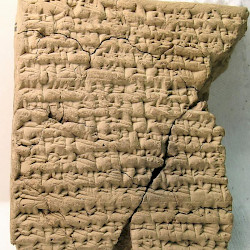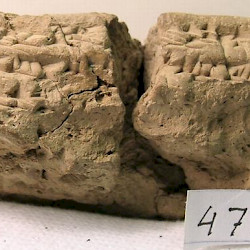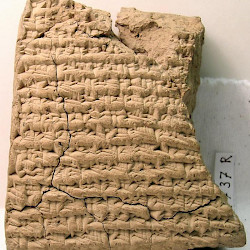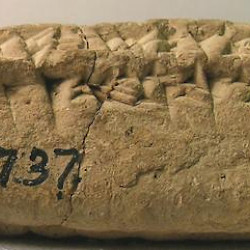BCHP 17 (Judicial Chronicle)
The Judicial Chronicle concerning Temple Robberies is one of the Mesopotamian chronicles written in ancient Babylonia in the Hellenistic Period.
The Judicial Chronicle concerning Temple Robberies is a Mesopotamian chronicle written in ancient Babylonia in the Hellenistic Period. one of the Mesopotamian chronicles written in ancient Babylonia in the Hellenistic Period. It describes events in 34 and 90 SE (i.e., 278 and 222 BCE) and therefore belongs to the reign of the Seleucid king Antiochus III the Great.
On this webpage, a new reading is proposed; the official publication will be in I.L. Finkel, R.J. van der Spek, R. Pirngruber, Babylonian Chronographic Texts from the Hellenistic Period (2020; = BCHP; Writings of the Ancient World).
Description of the tablet
The tablet has the form of a Neo-Babylonian business document and is fairly well preserved. The entire left edge and the greater part of the upper and lower edges are still extant; only the right edge is lost. The original size of the tablet was c. 9.5 x 7.6 cm. The upper edge, as preserved, measures 7 cm, but must have been c. 2.5 cm. longer. The left edge is entirely preserved and measures 7.6 cm. The length of the preserved part of the lower edge is 5.8 cm.
The thickness of the upper end at the left edge is 1.5 cm, at the highest point which will have been the middle of the tablet, 2.0 cm, and at the right end 1.8 cm. The thickness of the lower edge at 2.5 cm is also 1.8 cm; hence the conclusion that c. 2.5 cm is missing at the right end at the upper part. The length of line 1 is 6.5 cm, line 6 measures 5 cm. The entire length of line 1 probably was 9-9.5 cm, which gives an extra space of c. 5 signs. It is not known whether the right edge was inscribed; the left edge was not. This reconstruction of the tablet fits in with the content of the tablet.note
Previous editions
- F. Joannès, "Une chronique judiciaire d' époque hellénistique et le châtiment des sacrilèges à Babylone" in: J. Marzahn, H. Neumann, A. Fuchs eds., Assyriologica et Semitica. Festschrift für Joachim Oelsner anlässlich seines 65. Geburtstages am 18. Februar 1997. AOAT 252 (Münster 2000), 193-211.
- J.-J. Glassner, Mesopotamian Chronicles, edited by Benjamin R. Foster (Atlanta 2004), no. 37, p. 256-9.
Commentary
This document is a collection of three court proceedings concerning theft of temple property. Temple robbery is a theme which gets a great deal of attention in the Astronomical Diaries. Joannès discussed the relevant passages, and our commentary can best be seen as an addition to his publication (Joannès 2000). The robbery of 34 SE = 278 BCE is even mentioned in the Diaries. It shows again the close relationship between the diaries and the chronicles.
The court proceedings include interrogation under torture, subsequent conviction, and the punishment is death penalty by burning. The last case mentioned here is exceptional in that the accused did not admit their crime at first, that one of the accused died afterwards in jail and that the others complied after a second interrogation under torture.
A special arrangement was made for the wife of one of the convicted. It may have been a penalty as well, or she was taken up in temple service as she probably had no husband or son left to maintain her.
The chronicle has a resemblance with the Gold Theft Chronicle (BCHP 15), which also reports temple robbery, this time from the Day-One-Temple (=New year's festival Temple (?)) and where the thieves are also interrogated on the rack of interrogation, convicted and sent to the stake.
[Obv.1] Year 34th, Antiochus (I) and Seleucus kings, month Arahsamna (VIII = 22 October-20 November 278 BCE). [That month, nth day,]
[Obv.2] Babylonian men, Babylonian women and soldiers [of .. .. .. .. ..,]
[Obv.3] who had entered the Juniper garden illegally and had stolen5 [property of Bêl],
[Obv.4] Bêltia, Ištar of Babylon and the [great] gods [(.. .. .. .. ..)]
[Obv.5] were burnt with fire.
------------------------------------------
[Obv.6] Year 90th, month Ululu (VI). That month, day17[th (19 September 222 BCE), PN]
[Obv.7] and one brother of his, concerning a cr[ime (of theft) which]
[Obv.8] they had committed, in the presence of Nergal-(ina-)teši-[etir, the šatammu of Esagila and],
[Obv.9] the Babylonians of the kinishtu of Esagila /and\ [in the jail (or: in front)]
[Obv.10] of the judges of the temples behind the [….. Ga]te,
[Obv.11] were h[anged?] on a rack of interrogation [and were interrogated.]
[Obv.12] They were convicted. That day they were burnt with fire.
------------------------------------------
[Obv.13] Year 90th, month Ajaru (II = 8 May-6 June 222 BCE). That month, the shatammu of E[sagila and]
[Obv.14] the Babylonians of the kinishtu of Esagila, because of [a theft] entered[16]
[Obv.15] the treasury, the territory of the great gods [(…)].
[Lower edge.16] Silver, [gol]d, precious ston[es and .. .. .. .. ..]
[Lower edge.17] which (belong to) the territory of the godhead, in great number [were stolen].
[Lower edge.18] That month [the thieves …]
[Rev.19] who [had stolen] from [the treasury aforementioned]
[Rev.20] were arrested (and) captured[21] in [the jail of the judges of the temple].
[Rev.21] That month, day 2+x[th Bêl-zera]-lišir, the goldsmith, Bel-xxx,]
[Rev.22] the jeweller, the trust[ee of] the temple[s .. .. .. .. .. .. .. ..]
[Rev.23] and Bêl-šarâ, the gate keeper [of the treasury]
[Rev.24] were interrogated[27] on the rack of interroga[tion in the presence of the judges]
[Rev.25] of the temples, the shatammu of Esagila, [the Babylonians of the kinishtu]
[Rev.26] of Esagila (and) the people of the land, below [the ... Gate]
[Rev.27] outside (the wall). (However,) they could not convict29 Bêl-zera-[lišir, the goldsmith]
[Rev.28] that he had stolen the silver and the gold, nor Bel-[xxx, the jeweller],
[Rev.29] nor the gate keeper, (but) [they were kept] in [jail].
[Rev.30] Day 7th, Bêl-zera-lišir, the goldsmith, [died] in jail.
[Rev.31] His corpse was carried out and burnt with fire. [That] day, Bêl-xxx,]
[Rev.32] the jeweller, his two sons, the gate keeper and [his sons]
[Rev.33] were interrogated as previously, were convicted (and) [burnt] with fi[re].
[Upper edge.34] The wife of Bêl-šarâ, the gate keeper, .. [.. .. .. .. .. .. ..]
[Upper edge.35] who was captured? afterwards, [was convicted?] around? month Nisanu, ye[ar 91?]



